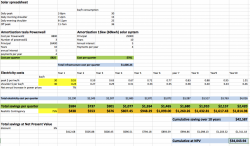At least 6 nuclear reactors producing baseload power with no CO2 emissions.
Not if the recent US examples are anything to go by. There is now just one project continuing and its future is doubtful. The figures are in USD btw.
The owners of the two latest and greatest have pulled the plug and will scrap them as the construction costs have blown out (and bankrupted one of the construction companies).
Attorney: Utilities meant to hide report on nuclear project
State-owned Santee Cooper and South Carolina Electric & Gas hired Bechtel Corp. in 2015 to assess construction on two new reactors at V.C. Summer Nuclear Station north of Columbia. The utilities were briefed on the findings later that year, though the official report is dated February 2016.
Essentially, the report says "this wasn't going to work. ... If things don't change dramatically, you'll never finish these projects," Elliott said. Its findings included a lack of proper oversight by SCE&G, the majority owner.
SCE&G should have disclosed the report's existence as it successfully sought approval in 2015 and 2016 to spend more on the project. Instead, executives told state regulators they were confident in the presented completion dates, said Elliott, also an attorney for South Carolina Energy Users Committee, a coalition of large industries that need a lot of energy.
The utilities abandoned the project July 31
after jointly spending nearly $10 billion, leaving nearly 6,000 people jobless. A 2007 state law allows SCE&G to recoup its debt from customers if state regulators determine money was spent prudently.
Legislators who are seeking ways to fix the law want to stop that. Customers have already paid more than $2 billion on interest costs through a series of rate hikes since 2009.
The project accounts for 18 percent of SCE&G customers' electric bills.
The U.S. Backs Off Nuclear Power. Georgia Wants to Keep Building Reactors.
The Vogtle expansion is also backed
by $8.3 billion in federal loan guarantees awarded by the Obama administration.
Critics
noted that the Vogtle project could still be plagued by cost overruns, which would be passed on to ratepayers. The AP1000 is a novel reactor design, reported to have more safety features than previous models, and engineers have so far struggled with the project. Construction began before Westinghouse had finalized its design, and several safety changes
had to be made midway through the process that pushed
costs far past the initial estimates of $14 billion.
The company, which has partnered with three other utilities on the project, said it expected the new reactors would cost roughly $19 billion and come online in 2021 and 2022.















